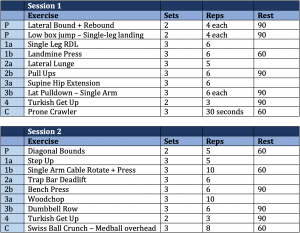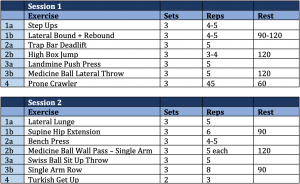6-Week Preparation Period for Handball
We have previously looked at a preparatory training week, targeting the 3 big rocks of handball preparation;
1.Full body strength
2.Multi-direction speed and change of direction
3.Energy systems development
While this gives a good indication of the types of exercises and drills that can be performed, looking at only one week doesn’t indicate the variation and progression required over a preparation period.
So here we will look a little more into a 6-week progression.
Week 1
Week 1’s training layout will simply be the program layout from the previous discussion.
As touched upon, during this foundational stage, we want a lifting program that is;
-Whole-body
-Includes some basic landing mechanics
-Involves single-leg strength
-Anterior and posterior chain (front and back)
-Involves movement in all 3 planes, not just the over-trained sagittal plane
-Is Low-to-moderate in terms of volume
-Involves the selection of exercises that relate to handball movements, but that also allow progression from one period to the next.
Starting out with 2 sessions per week, our lifting sessions were as follows;

For simplicity’s sake, we removed the warm-up exercises from the tables. Both layouts involve a very similar layout in terms of the boxes being ticked;
-Beginning with a plyometric exercise, predominantly targeting landing mechanics
-A single-leg anterior dominant movement
-A lower body posterior dominant movement
-An upper body push and an upper body pull (one day vertical, and the other day horizontal)
-Rotation work and a core exercise
-Importantly, all 3 planes of motion are targeted.
With our running and conditioning-based work, the important things that need to be addressed even at this early stage are;
1.Acceleration, deceleration and direction change
2.Laying a foundation of aerobic ability
For point one, this doesn’t mean targeting these tasks at maximal speed and aiming to develop these right from the outset. Rather about introducing them at a low level right from the start, to progressively build on over the course of the pre-season – and build on in terms of intensity and complexity. At this stage, these will be very basic and very low impact.
Generally in the very earliest stages of this period, conditioning work will begin outdoors on a field. This is largely due to the increased space – meaning that you aren’t needing to perform a large volume of direction changes under fatigue so early in your preparation.
Day 1
1.Shuttle #1
Distances at 5, 10, 15 and 20 meters.
Performed no faster than 50% speed, controlling the switch from running to back-pedalling. Perform 3 repetitions with a 1.5-2 minute rest between each.
2.30/30 Tempo Runs
2 x (8-10 x 30 on /30 off)
Day 2
1.V-Drill
Perform 2 revolutions of the V, once again sticking to 50% of your maximal effort/speed. Once again, 3 repetitions with 1.5-2 minutes rest, with particular attention paid to each direction change – controlled and smooth.
2.Repeat Distance
4 x 400 meters
Nice and simple to understand here, 400 meters, repeated 4 times, with a 1.5-2 minute recovery between each. Run the 400’s at 75-80% speed, and give yourself at least as much recovery as the time it takes you to run the 400 (1:1 work: rest ratio), or slightly more.
Week 2
The general principles of progression over the coming weeks, and with preparation in general are;
1.A gradual increase in both total training volume and intensity
2.An early emphasis on whole body stability and mobility and full body strength through controlled movements, becoming progressively more specific strength and power focused.
3.Eventually volume begins to be reduced, yet intensity remains high – and generally continues to increase (in terms of both speed as well as complexity of movement).

This week with exercises remaining similar (as should be the case over a 6-week period – there is no point changing 50% of exercises from week to week), the primary progression is to perform movements back-to-back before rest. So ‘1a’ is performed and immediately followed by ‘1b’ before getting a rest. There is also a little more total volume.
It is a similar story with running, with progression being gradual, and here demonstrating this with the same drills.
Running Day 1
1.Shuttle #1
Distances at 5, 10, 15 and 20 meters.
Performed now at 75% speed, controlling the switch from running to back-pedalling. Perform 3 repetitions with a 1.5-2 minute rest between each.
2.30/30 Tempo Runs
2 x (10 x 30 on /30 off)
Running Day 2
1.V-Drill
Perform 2 revolutions of the V, increasing to 75% of your maximal effort/speed. Once again, 3 repetitions with 1.5-2 minutes rest, with particular attention paid to each direction change – controlled and smooth.
2.Repeat Distance
4 x 400 meters
This one remains the same for one more week. 400 meters, repeated 4 times, with a 1.5-2 minute recovery between each. Run the 400’s at 75-80% speed, and give yourself at least as much recovery as the time it takes you to run the 400 (1:1 work: rest ratio), or slightly more.
Week 3

Slightly more plyometric added in, and more regular Turkish Getups, and hypothetically higher loads being lifted on the lifts. Lifts are still a controlled tempo, building that foundation.
Above: Prone Crawler
Running Day 1
1.Shuttle #1
Distances at 5, 10, 15 and 20 meters.
Performed now at 85-90% speed, controlling the switch from running to back-pedalling. Perform 3 repetitions with a 1.5-2 minute rest between each.
2.15/15 MAS Grid
2 x (14 x 15 on /15 off)
15 seconds on to cover the distance to the other marker (70-75 meters a good starting point), followed by 15 seconds of complete rest before turning back the other direction for the next 15-second effort.
These should feel fairly comfortable early in the set, so don’t fall into the trap of laying out too long a distance.
Running Day 2
1.V-Drill
Perform 2 revolutions of the V, increasing to 90-100% of your maximal effort/speed. Once again, 3 repetitions with 1.5-2 minutes rest, with particular attention paid to each direction change – controlled and smooth.
2.Repeat Distance
6 x 200 meters
Executed at 90%, with 45-second recovery between each.
Week 4

Once again some slight tweaks to the exercises performed – in terms of difficulty and specificity.
Movements are still controlled, and with loads continuing to increase. However, at this stage can be where attention begins to turn to a more powerful intention on the concentric part of the certain movements. For example, when performing the bench press, still control the lowering of the bar, but then place a greater intent into pushing the bar back up faster. Or on the step-ups, as you drive your foot into the step, do this with the intension of accelerating through the movement and driving the opposite knee up. Note, this doesn’t apply to certain exercises like the Turkish get up and pullups and the like.
Running Day 1
Here, only in week 4 of our preparation do we finally build up to 100% top speed efforts. And even these are built up to by the 2nd and 3rd set of things, and still done conservatively.
1.Shuttle #1
Distances at 5, 10, 15 and 20 meters.
Performed now at 100% speed in set 2 and 3, controlling the switch from running to back-pedalling. Perform 3 repetitions with a 1.5-2 minute rest between each.
2.15/15 MAS Grid
2 x (18 x 15 on /15 off)
Running Day 2
1.V-Drill
Perform 2 revolutions of the V, 100% of your maximal effort/speed. Once again, 3 repetitions with 1.5-2 minutes rest, with particular attention paid to each direction change – controlled and smooth.
2.Repeat Distance
8 x 200 meters
Same approach here as in week 4, just with a couple more repetitions. Executed at 90%, with 45-second recovery between each.
Week 5

Total Volume starts to reduce, but intensity continues to increase (in combination of both higher load in some exercises such as trap bar deadlift, and faster movement in other exercises like the bench press.)
We also see exercises like the landmine push press replacing the landmine press, and the introduction of medicine balls.
Running Day 1
It is important to touch on that in this 6-week phase, we don’t transition to the court at all, in terms of our physical preparation. This is largely due to potential availability for personal use as well as the distances required to be run (there would be too many direction changes performed under fatigue for this stage of the year, in a small court area.) Additionally, you will perform plenty of court-based work when back in the team setting.
So when performing your own work, the general approach is to continue to shorten the distances and increase the intensities.
1.Shuttle #2
Distances at 5, 10, 10 and 5 meters.
Performed now at 100% speed in set 2 and 3, controlling the switch from running to back-pedalling. Perform 3 repetitions with a 1.5-2 minute rest between each.
2.15/15 MAS Grid
2 x (20 x 15 on /15 off) – performed at a slightly longer distance.

Running Day 2
1.T-Drill
Perform 2 revolutions of the T, at 100% of your maximal effort/speed. 3 repetitions with 1.5-2 minutes rest, with particular attention paid to each direction change – controlled and smooth.
2.Repeat Distance
1 x 100 meters (75%)
1 x 80 (85-90%)
4 x 60 (90%)
4 x 40 (90%)
(30 seconds rest between each)

Week 6

This week there is a considerable change in the introduction of super-setting a strength exercise with a powerful plyometric or medicine ball exercise (sometimes called ‘French contrast training’). In any case, it certainly is on the advanced side – and shouldn’t be performed in beginner level athletes (as there is little benefit to be gained if you are a beginner anyway, as you will not be lifting heavy enough nor moving fast enough to derive the benefit). Additionally, you will notice that it combines exercises that have been performed consistently for over a month now. What we are doing here is taking strength (or the execution of strength just performed), and immediately applying it to a more specific and faster movement – relevant to our game. (Trap Bar followed by a powerful jump, bench press followed by a powerful rotation and throw, step up followed by powerful lateral jumping).
Beyond that, volume reduces while intensity rises. We are certainly much further along the ‘specificity’ spectrum than we were 6 weeks ago.
Running Day 1
It is important to touch on that in this 6-week phase, we don’t transition to the court at all, in terms of our physical preparation. This is largely due to potential availability for personal use as well as the distances required to be run (there would be too many direction changes performed under fatigue for this stage of the year, in a small court area.) Additionally, you will perform plenty of court-based work when back in the team setting.
So when performing your own work, the general approach is to continue to shorten the distances and increase the intensities.
1.Shuttle #2
Distances at 5, 10, 10 and 5 meters.
Performed now at 100% speed in set 2 and 3, controlling the switch from running to back-pedalling. Perform 3 repetitions with a 1.5-2 minute rest between each.
2.15/15 MAS Grid
2 x (20 x 15 on /15 off) – performed at a slightly longer distance.
Running Day 2
1.T-Drill
Perform 2 revolutions of the T, at 100% of your maximal effort/speed. 3 repetitions with 1.5-2 minutes rest, with particular attention paid to each direction change – controlled and smooth.
2.Repeat Distance
2 x 80 (85-90%)
4 x 60 (90%)
6 x 40 (90%)
6 x 20 (90%)
(30 seconds rest between each)
Important to note is that this has only been a 6-week progression, and a general one at that. This speed of progression, as gradual as it has been, would still be too quick for some players (especially those who are new to physical preparation). 6 weeks is a very short length of time, and indeed in Strength & Power Training for Handball and Agility speed & Conditioning for Handball, the preparation layouts are for 12 weeks at least. And importantly, the solution is NEVER to attempt to cram 10-12 weeks of training and progression into 6 weeks by doing more each week. Nor is it ever to skip certain stages, and get to the more specific elements of preparation. This will almost certainly guarantee injury at same stage as well as a lack of performance.
But this 6-week progression should give a good outline of the way to progress even from week to week – and how these progressions and changes need to only be subtle ones (a little more load here, a slightly faster movement there) and of course be directed by what your specific goals or needs are.
I have endeavoured to keep this discussion as short and to-the-point as possible. We cover these concepts in far greater detail in Strength & Power Training for Handball and Agility speed & Conditioning for Handball, so check those out.
Fire through any questions you may have, and check out the rest of the articles.
Fitness Coach

